Welcome to the official website of Arstayl Youtube channel!
Before starting the review, let's dive into a little history ...
At the end of 2012, Google and LG presented the first fruit of their cooperation - the Nexus 4 smartphone, which was not so much successful as it had an excellent appearance and the most powerful stuffing at the time of release. As a result, they set the price at $300, which made this device a real hit - the fans of the line were delighted.
At the end of 2013, the most successful device in the Google smartphone lineup, the Nexus 5, was released, which was already the second device manufactured by LG. The Nexus 5 went on sale for $350-400, and once again devastated warehouses and a shortage of commercial copies followed - that's how the Nexus 5 triumphantly began its march! At the end of 2013 there were no alternatives for the Nexus 5, even among Chinese companies!
Cameras.
There are two cameras, the front camera is 5 megapixels, and it is not very interesting - you can skip it. The main camera has Sony's latest 12.2MP F2/0 aperture sensor with large pixels, which will allow you to take better pictures in low light conditions. Takes really great late at night! The main camera also has a duo of laser autofocus (hello, LG G4!) and dual-color LED flash at its disposal. The original Nexus 5 also had optical camera stabilization at its disposal, but it is not here.
Speaking about the very quality of shooting, it can be safely called good - the results are approximately at the level of the best flagships from the same LG and other companies. The main camera has the ability to record 4K video at 30 FPS.


The front camera is quite suitable for selfies, but I expected better shooting quality:

Evaluating the cameras, we can say that they were a success: an excellent sensor with large pixels allows you to get very little noise in difficult shooting conditions, and shooting under normal conditions is generally easy for the camera. It wouldn't surprise me that Google could improve the quality of the cameras even more with the update, as it did with the original Nexus 5.
Conclusions:
The gadget supports most wireless modules, but you will not find support for the above-mentioned wireless charging in it. 4G and NFC are present. The quality of network reception and the quality of communication does not raise questions.
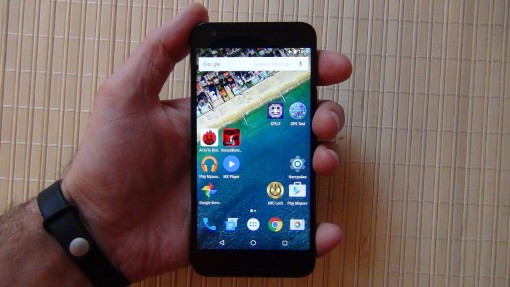
At the time of writing, there are already a huge number of well-known Chinese companies on the market that can offer the same stuffing as the Nexus 5X, but at a more modest price. At the time of its release, Nexus5 simply had no alternatives, and this device was really unique - cheap hardware from famous brand with a clean operating system from Google.
Times are changing, and the effect of admiration from this smartphone is no longer happening. Despite all this, it cannot be said that the smartphone came out somehow unsuccessful - it is a direct successor to the original, successful Nexus 5.
In Russia, the official price for the version with 32 GB of memory was about 37-38 thousand rubles (at the time of this writing), which is a lot: the Nexus 5X does not have the status of a flagship smartphone, and the general filling simply does not pull on this money and flagship status. For 40 thousand rubles, you can take, for example, the flagship LG G4, which surpasses the Nexus 5X in many ways (except for the battery, of course). We are preparing a comparison review of LG G4 and LG Nexus 5X.
, . .Specifications
- Body materials: plastic, glass
- Operating System: Android 6.0 Marshmallow
- Network: GSM/EDGE, UMTS/HSDPA, LTE Cat.6 (nanoSIM)
- Platform: Qualcomm Snapdragon 808 (MSM8992)
- Processor: Quad-core 1.44 GHz (Cortex-A53) and dual-core 1.8 GHz (Cortex-A57)
- Graphics: Adreno 418
- RAM: 2 GB (LPDDR3)
- Storage Memory: 16/32 GB
- Memory card slot: no
- Interfaces: Wi-Fi (ac/b/g/n) Dual-Band, Bluetooth 4.1 (LE), USB type-C (USB 2.0) for charge/sync, 3.5 mm for headset
- Screen: IPS LCD, diagonal 5.2", resolution 1920x1080 pixels, ppi 423, automatic backlight level adjustment, protective glass Gorilla Glass 3
- Primary camera: 12.3 megapixels, 1.55 nm pixel size, f/2.0, laser focusing, dual LED flash, 4k video recording
- Front camera: 5 megapixels without autofocus, pixel size 1.4 nm, f/2.0
- Navigation: GPS (support A-GPS), GLONASS
- Optional: Nexus Imprint fingerprint scanner, accelerometer, light sensor, proximity sensor
- Battery: 2700 mAh
- Dimensions: 147 x 72.6 x 7.9mm
- Weight: 136 grams
For those who do not follow the smartphone market closely, let me briefly remind you. The Nexus line are smartphones developed by various companies in partnership with Google and which are, in fact, a reference design of an Android device with certain characteristics. These devices are the first among all Android smartphones to receive updates to new versions of the operating system and are usually very good in terms of performance. Over the years, Google chooses different manufacturers to create new models in the Nexus line, but sometimes the same manufacturer can release several models at once. Such a situation, for example, has developed with LG. The South Korean manufacturer introduced the Nexus 5 smartphone at the end of 2013, and now, two years later, the same company is creating a new device in the five-inch segment of the Nexus line - LG Nexus 5X.
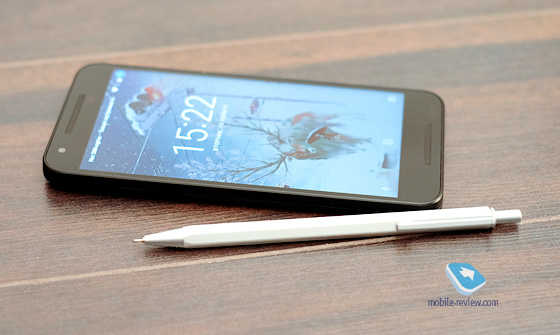
Design, body materials
In terms of design, the Nexus is usually very simple devices. Google's logic is clear - the company needs smartphones from the Nexus series to have a universal design that will either be liked, or, in worst case not evoke any emotion. It seems to be there, but it is barely caught, sterile, so to speak. In the case of the Nexus 5X, all the rules are met - the design here is determined by the location of some controls and the screen size and is devoid of any features or chips.
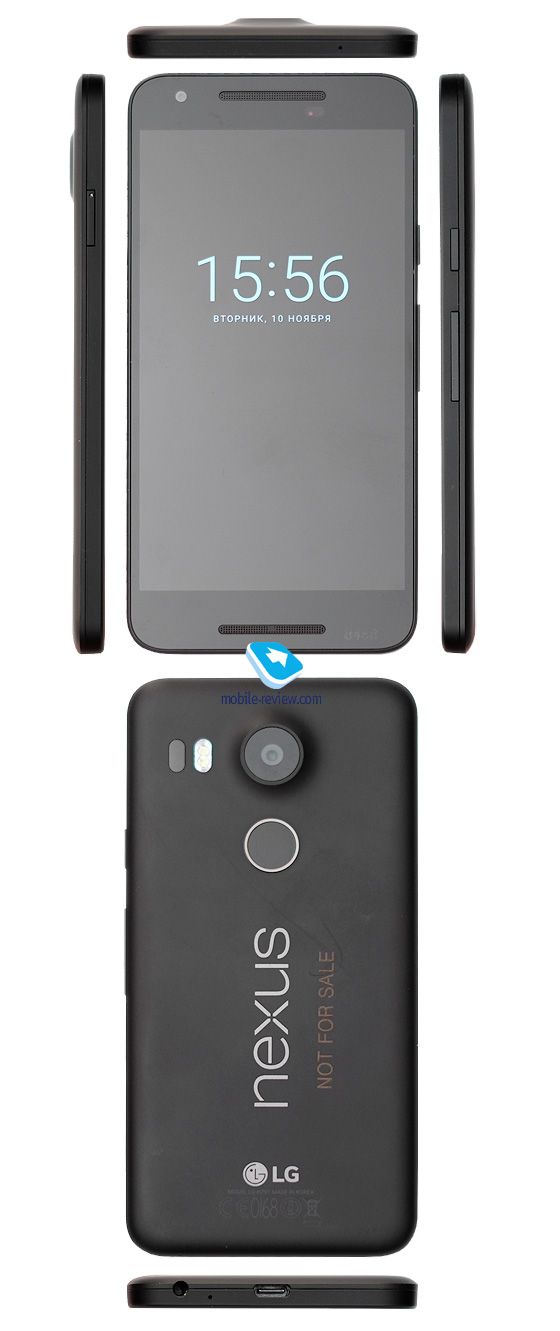
On the front, there is a Gorilla Glass 3 protective glass panel with an oleophobic coating and two speakers; on the back, a large camera module with additional elements and a fingerprint scanner, as well as the “nexus” logo, stand out.

It all looks simple together. If you are a fan of non-standard design, special body shapes, atypical or expensive materials, the LG Nexus 5X will hardly captivate you. Everything here is utilitarian, without zest. It was necessary to show the ringing and conversational dynamics in front? Here they are, top and bottom, covered with a grid. Need a fingerprint scanner? Right here, just above the center of the body on the "back". Camera module? Even higher on the ledge, massive, covered with protective glass. And so are all the elements.
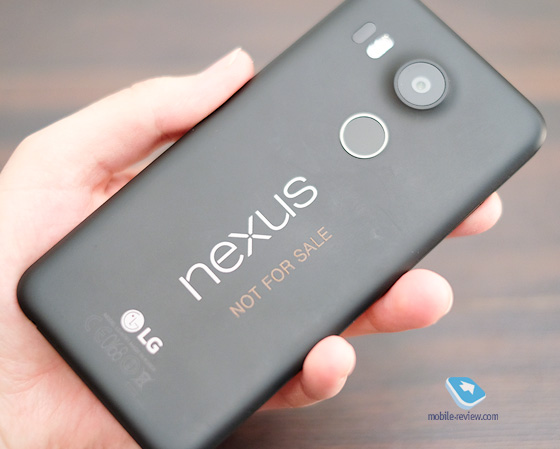
I have already mentioned the body materials above, but I will repeat myself. The entire front panel is covered with Gorilla Glass. Sidewalls - matte plastic. "Back" - pleasant to the touch plastic with the effect of "soft-touch" surface, moderately easily soiled, but comfortable: when you hold a smartphone, it lies securely in your hand and does not slip even from wet hands.
And about flowers. In Russia, the smartphone will be available in three colors: black, white and mint. In all cases, the front panel is completely black. In white, the 5X has a smooth plastic back.
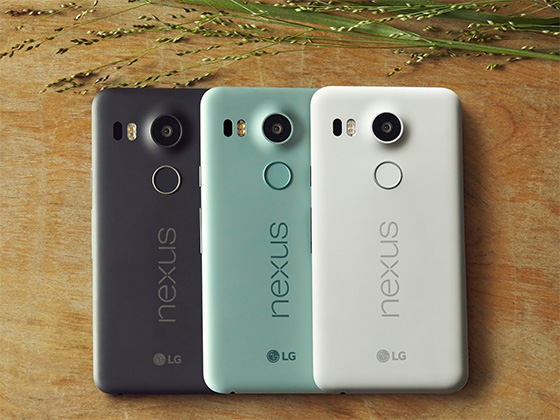
Image from the Internet
Assembly
The design of the smartphone does not imply removing the cover, the only removable element is the tray for a nanoSIM SIM card. In general, I did not have any complaints about the build quality even of the test sample during the week of using the device. I believe that the Nexus 5X, which have gone on sale, will also have no problems. Here, of course, we can recall the recent video about the "big brother" of the smartphone - the Nexus 6P from Huawei, where it is broken in half by the effort of two hands and will. But, in my opinion, the value of such videos is not too great and they do not carry practical information. If you wish, you can break in half almost any modern smartphone, except, probably, protected models.

Dimensions
To the dimensions of the Nexus 5X, I have one gripe. The fact is that when you pick up the device for the first time, in terms of dimensions it resembles smartphones with a diagonal of 5.5 inches. Of course, I'm talking about a conditional person who often changes tubes and distinguishes between 5 and 5.5-inch form factors at the reflex level. But even if you do not constantly change devices, but use some kind of smartphone with a diagonal of 5 "", then, switching to Nexus 5X with a 5.2" screen, you will expect dimensions from it close to your previous smartphone. In practice, it turns out to be comparable to models with a 5.5" screen. I can't say it's definitely bad. It is clear that 5.2 is just a cross between 5 and 5.5, but deep down I expected that the new Nexus would be closer in size to five-inch devices. Alas.
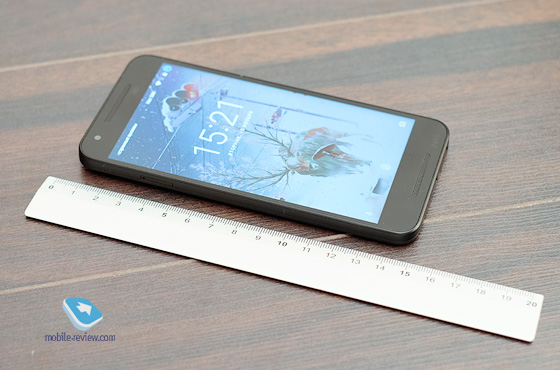
To estimate the dimensions of the LG Nexus 5X, I suggest you take a look at the list with the dimensions of the current flagships:
- Apple iPhone 6 Plus(5.5"") - 158.1 x 77.8 x 7.1 mm, 172 grams
- LG G4(5.5"") - 148.9 x 76.1 x 9.8 mm, 155 grams
- (5.2"") - 147 x 72.6 x 7.9 mm, 136 grams
- Samsung Galaxy S6(5.1”) - 143.4 x 70.5 x 6.8 mm, 138 grams
- HTC One M9(5"") - 144.6 x 69.7 x 9.6 mm, 157 grams
- LG Nexus 5(4.95"") - 137.9 x 69.2 x 8.6 mm, 130 grams

Compared to HTC One M9
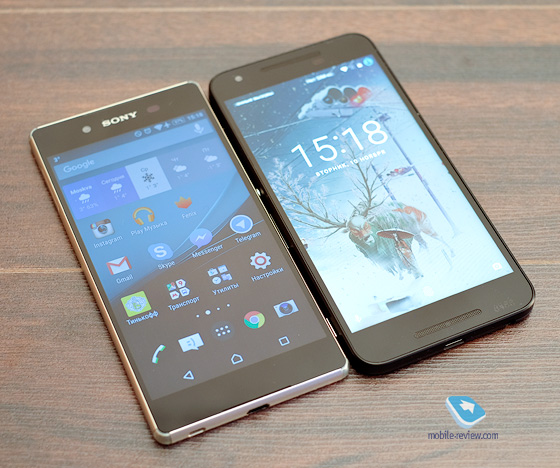
Compared to Sony Xperia Z3 Plus

Compared to Meizu MX2

Compared to LG G4
The device is quite comfortable in the hand, you can carry it anywhere - the weight allows and does not weigh down at all.
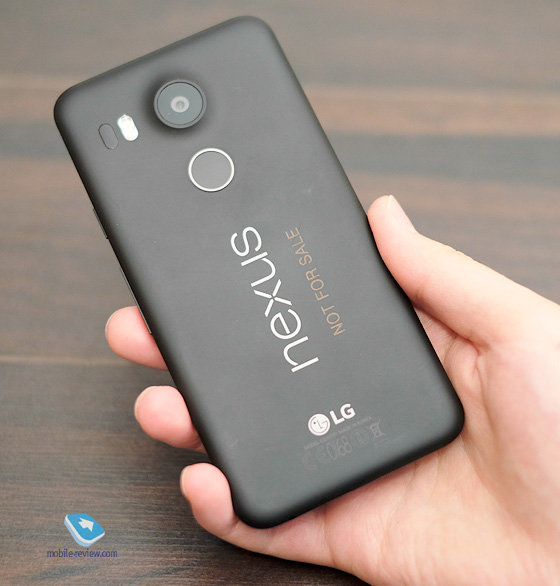
Controls
Unlike the company's native G-series smartphones, the Nexus 5X is a device for Google, and the controls here are laid out and implemented in a completely different way. I can’t say that it’s convenient, but to be honest, it’s completely inconvenient. But first things first.
Let's start with the power and volume keys. Both are located on the right edge, but the power button turned out to be higher than the volume rocker, and you need to get used to it, because in most devices where the same set of keys is on the right edge, their order is reversed: the volume rocker is on top, lower, closer to the center of the edge – power button. For me personally, the location of these keys in the Nexus 5X is inconvenient, but at the same time, I understand perfectly well that if you buy a smartphone for yourself, you will get used to this arrangement of elements. A matter of habit, nothing more.

Above the screen are the speaker, sensors and front camera eye. The second speaker is located under the screen, approximately in the middle a light indicator is inserted into it, notifying about missed and new events (calls, messages, and so on).
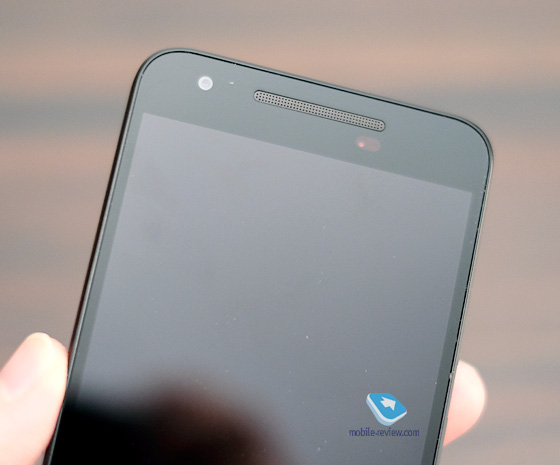
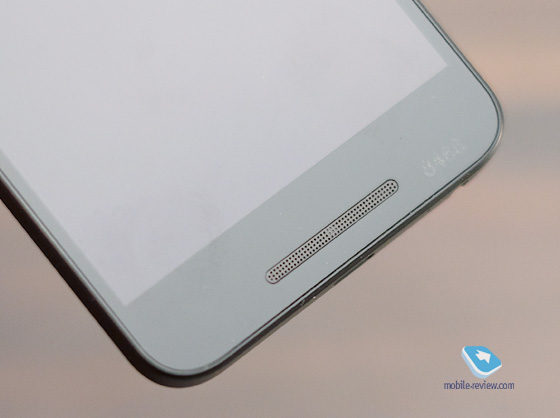
At the top there is an additional microphone (“noise reduction”), at the bottom there is a 3.5 mm mini-jack, USB Type-C format and the main microphone.
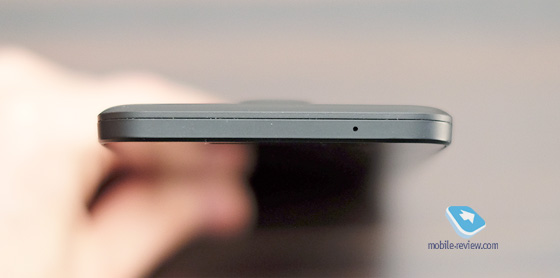
The left edge is almost empty, except for the SIM card slot (nanoSIM), there is nothing here.
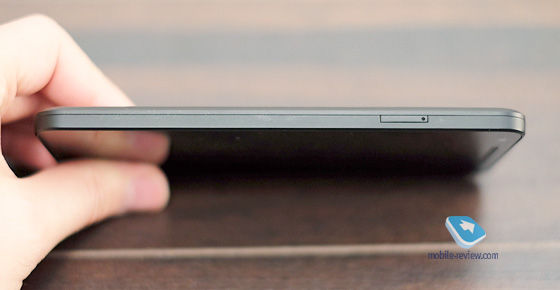
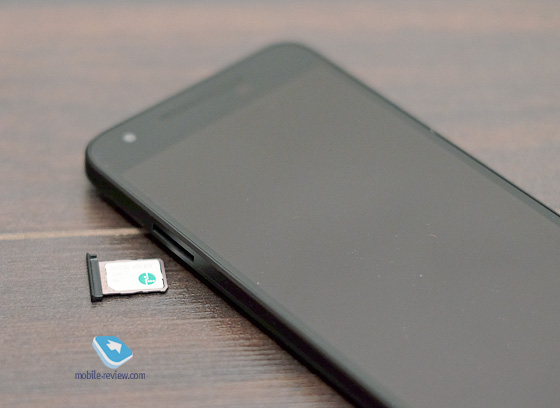
On the "back" of the smartphone is a fingerprint scanner. It is large in size if you hold your smartphone in right hand, then the index finger will be most convenient to scan. In total, up to five casts of a finger (or different fingers) can be taken. The recognition accuracy is very high, in a week of using the LG Nexus 5X I had literally a couple of incorrect recognitions.


Screen
The LG Nexus 5X has a 5.2" IPS screen. Display resolution - 1920x1080 pixels (424 ppi). The display is calibrated as neutral as possible.

The screen has a good margin of brightness, there is also an option "adaptive brightness", if you enable it, the system will automatically adjust the brightness level depending on the lighting conditions, but also taking into account the value you set. That is, if you unscrew the slider to the maximum brightness, with the option enabled, it will not sag much.
The viewing angles of the display are close to the maximum, except that at a very strong angle the picture is slightly brightened. The color scheme is calm, I did not notice a strong attraction to warm or cold tones. Perhaps the company overdid it a little with lowering the contrast, the image looks too calm, I personally even lacked a little juiciness in it, but this is a matter of personal preference. In general, the screen is not bad.

Like Motorola's Nexus 6, the Nexus 5X features Active Display: when you take your smartphone in your hand, the time lights up on the screen and new notifications are shown in a muted mode. The same thing happens if the smartphone just lies on the table and a new notification arrives, it is displayed in a muted mode.
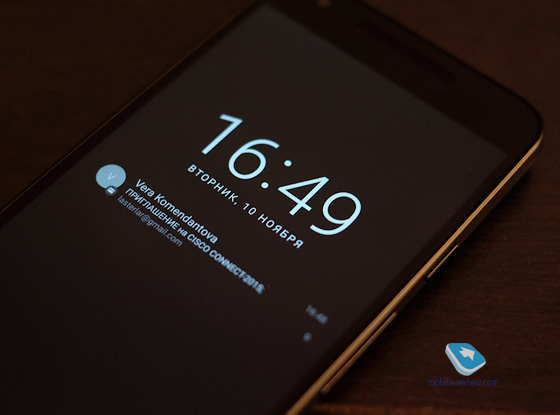
Camera
The main camera in the LG Nexus 5X deserves close attention at least because of its characteristics: a module with a resolution of 12.3 megapixels, a pixel size of 1.55 nm, f / 2.0, dual LED flash, and laser focusing. All together it should give excellent results. For a complete set, only optical image stabilization is missing.
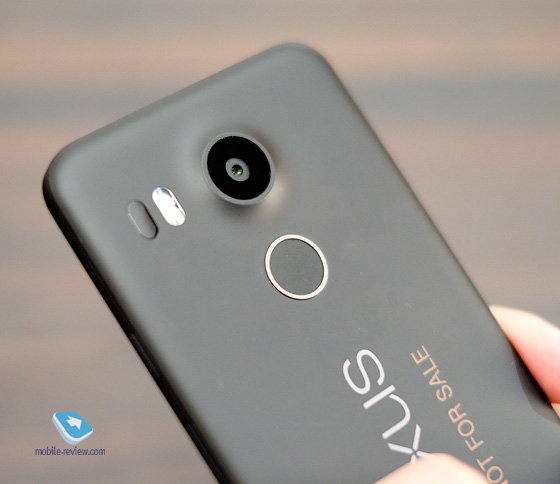
The camera interface is very simple, using the basic Android Camera app. This is the drawback, out of the box the smartphone does not have a manual shooting mode, like the LG G4, for example, and cannot take pictures in RAW.

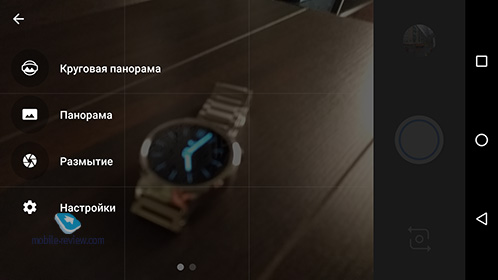

Accordingly, the camera has very few settings: you can change the resolution for photos and videos, turn the flash on and off, and also select the HDR + mode - auto, on or off. By default, the HDR + option is set to "Auto", so I took all the photos on the smartphone in this mode.
For clarity, I will compare the photos taken on the LG Nexus 5X with the LG G4, equipped with one of the best cameras among current smartphones.
Shooting on a sunny day
| Nexus 5X | LG G4 |
 |
 |
 |
 |
 |
 |
 |
 |
 |
 |
 |
 |
 |
 |
 |
 |
 |
 |
 |
 |
 |
 |
 |
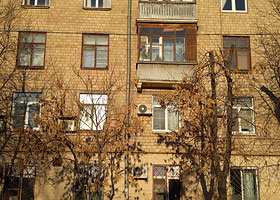 |
 |
 |
 |
|
 |
 |
In general, the frames are comparable. Photos from the LG G4 have more detail, while those from the Nexus 5X appear to be deeper and more voluminous. In practice, the situation is as follows: in the Nexus 5X, the pictures are subjected to serious post-processing and due to this they look good on the smartphone screen, but you need to understand that they are not quite correct in terms of brightness, contrast and sometimes white balance. With the LG G4, everything is exactly the opposite: the photos do not look so spectacular, but they are as close to reality as possible in all color parameters. In the picture, you actually see exactly what you saw with your own eyes a second before, without embellishment.
Shooting in cloudy weather
| Nexus 5X | LG G4 |
 |
 |
 |
 |
 |
 |
 |
 |
 |
 |
 |
 |
 |
 |
 |
 |
 |
 |
 |
 |
 |
 |
 |
 |
Everything repeats itself - the frames from the Nexus 5X look better on the smartphone screen, but the photos taken on the LG G4 are closer to reality, they do not have such strong post-processing, and, accordingly, if desired, they can be pulled up in the editor. But at the end you get just a high-quality picture.
Shooting indoors
| Nexus 5X | LG G4 |
 |
 |
 |
 |
 |
 |
 |
 |
 |
 |
 |
 |
Indoors, the situation is about the same, photos from the LG G4 are sharper (due to stabilization) and closer to reality in terms of white balance.
The standard Android camera has a background blur mode that looks something like this:


And here is the difference between HDR+ enabled and disabled.
Front camera with a resolution of 5 MP, the pictures are good, judge for yourself:


In my opinion, the camera in the LG Nexus 5X is excellent. Yes, it falls short of the flagship LG G4, Samsung Galaxy S6/Note 5, but the difference between them is very insignificant and is not even in the overall quality, but rather in the perception of photos. If you like juicier and brighter shots, then the Nexus 5X is even better than the LG G4, for example. Whereas the camera in the LG G4 is simply more versatile and allows you to get more accurate results without post-processing.
In addition to photography, the smartphone allows you to record video in maximum quality close to 4k (UltraHD, 3840x2160 pixels), as well as video with an increased frame rate of up to 120 fps. During video recording, tracking autofocus works, the video quality is good.
Camera Comparison (Roman Belykh)
Before giving short description The quality of the pictures taken on the Nexus 5X, I must say right away that the camera was a pleasant surprise.
Since Artem gave examples of frames from the LG G4, it became easier to navigate the parameters. Both gadgets functioned in HDR mode: in the case of LG, this is ordinary HDR (it works extremely adequately, almost imperceptibly), in the case of 5X, HDR +. It should be clarified that HDR+ is not an easy mode, it creates several frames in a row, a special algorithm is used, one high-quality frame is obtained with almost no digital noise, but with the HDR effect.
The first thing that catches your eye when comparing photos is the slightly overestimated contrast in the images from the Nexus 5X. It's not bad or good, it's just visually perceived better, photos from the LG G4 seem faded. On the other hand, G4 shots can still be somehow brought to mind, but 5X shots are unlikely to be edited - the software has already worked there. Maybe it's even for the best.
The second is the HDR effect. It's more interesting on Nexus: more information in very bright areas of the frame.
Thirdly, the viewing angle is larger on the LG G4. You will ask why? The fact is that Artyom set the aspect ratio to 4:3 in both cameras, but the native aspect of the LG G4 is 16:9.
The fourth is the nature of the noise reduction. This is where personal preference comes into play. I like when digital noise is not suppressed by simple pixel smearing, but is handled intricately by software. In the case of the LG G4, the software works on a “C grade”, the pixels are blurry, and detail is lost a little. I say so in the affirmative because the original RAW images are clear, although quite noisy. However, the nature of the noise is pleasing to the eye. In the case of the Nexus 5X, noise processing is minimal, the software only cares about color reproduction, white balance and contrast. Sometimes, when a low-quality video is ripped, editors deliberately add noise, the picture becomes visually sharper. I can say the same about the shots from the Nexus 5X - it gives the impression of a sharper photo.
Fifth is detail. Both gadgets give excellent sharpness. In the case of LG, the pictures come out with less contrast, and in the case of Nexus, they come out with more contrast. Therefore, again, visually it seems that the photos are more interesting at 5X. But this is an erroneous opinion. Just due to the high contrast, some details in the photo disappear.
Sixth. With white balance, the G4 and Nexus 5X have parity. The devices do an excellent job of processing photos. However, frankly, I will say that the LG G4 (I used it for several months) will still lie more often: yellowish, purple and other shades will appear.
Seventh - night shots. And here begins the battle for quality. The G4 is not only equipped with laser focusing, which works better than that of the Nexus 5X, but also with optical stabilization. Therefore, the G4 has a head start in slow shutter speeds and the minimum ISO value. What, in fact, the camera software does: increases the shutter speed, for example, up to 1/14 (the “stub” works effectively with such parameters), and the ISO decreases to 400-500. At the same time, the Nexus 5X sets 1/25 of a second (there is no stub, but your hands can fail), and ISO 800 and above. Naturally, the noise increases. However, once again it is necessary to praise the developers for creating excellent software for the Nexus camera: even at high ISO, the photos are of excellent quality, comparable to the frames on the LG G4. One more note. The fact is that the aperture in the G4 is F1.8, and in the Nexus 5X it is F2.0. It doesn't seem like much of a difference, but the background blur is noticeably stronger in photos taken with the G4.
So, for those who didn’t understand anything: the Nexus 5X camera can please even a demanding user like me. I am very surprised by the cool quality of the optics, the module and the nicely written frame processing software.
Offline work
The smartphone has a non-removable Li-Pol battery with a capacity of 2700 mAh. My LG Nexus 5X sample ran a full day, on average, into the evening or late at night. The load was as follows: an hour and a half of conversations, 10-20 text messages, Gmail, 3-4 hours of listening to music and about 1-2 hours of active use of the mobile Internet (Instagram, Twitter, Facebook, browser). In fact, I did not notice much difference in battery life between the LG G4 and LG Nexus 5X, with active use both smartphones sit down in the evening, with moderate use they work all day.
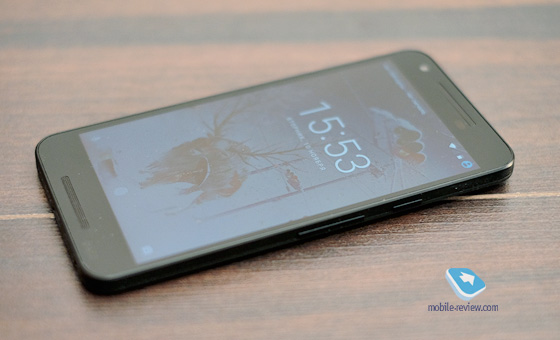
platform, memory
The smartphone, like the LG G4, is built on the Qualcomm Snapdragon 808 (MSM 8992) platform with a 1.44 GHz quad-core processor (Cortex-A53) and a 1.8 GHz dual-core processor (Cortex-A57), the graphics subsystem (GPU) is Adreno 418. The device has 2 GB of RAM and 16 or 32 GB of internal memory, there is no slot for a memory card.

The choice of a non-top platform seems to me appropriate here, as in the case of the LG G4. Moreover, the Nexus 5X has a lower screen resolution, and, accordingly, the performance requirements are even simpler than for the LG G4. The Qualcomm 808 platform provides a good level of performance without the drawbacks of the 810.
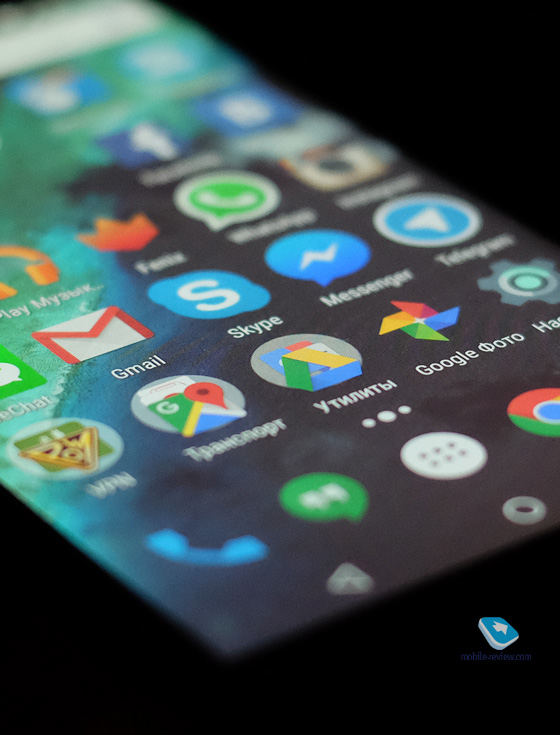
Performance, tests
As for the overall speed of the LG Nexus 5X, everything is fine here. The smartphone works smoothly, without delays and slowdowns. Of course, if you set out to find micro-lags in the process of flipping through screens or menu pages, this can be done by simply starting frantically scrolling the screens back and forth with maximum speed, but such a use case has nothing to do with real life. Below are the test results of Nexus 5X in Antutu.
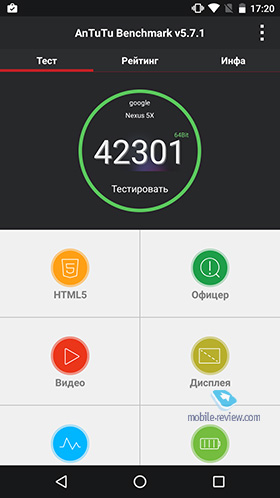

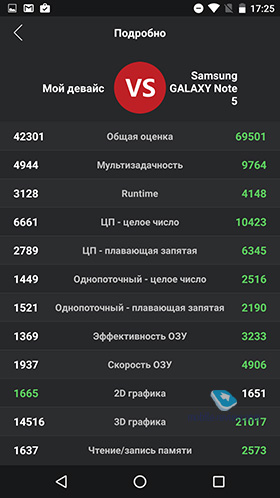

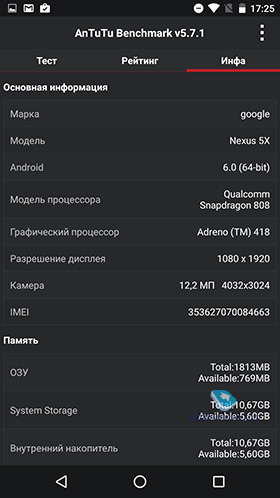
Interfaces
The smartphone works in GSM, HSDPA and LTE networks. For LTE, there is support for all common bands and frequencies, in Russian networks fourth generation the device works without problems.

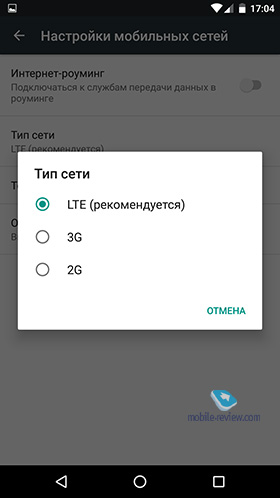
USB. For synchronization with a PC and data transfer, a bundled USB Type-C cable is used. USB 2.0 interface.
Bluetooth. Built-in Bluetooth 4.2 module with support for A2DP, LE (low energy) and Apt-X profiles.
Wi-Fi (802.11а/ac/b/g/n). The Nexus 5X uses a dual-band Wi-Fi module, this interface works flawlessly. Like any other modern Android smartphone, the 5X supports Wi-Fi mobile internet sharing (Wi-Fi router), as well as DLNA and Wi-Fi Direct standards.

NFC. The standard interface for any flagship based on Android since 2013 is also found in the LG Nexus 5X. Enabled and disabled in the settings, in the "Sharing and connection" menu.
Navigation
The smartphone supports GPS / A-GPS and Glonass, it takes a minimum amount of time to search for satellites. There is no special navigation software in Android smartphones for a long time, and manufacturers usually limit themselves to the pre-installed Google Maps, LG Nexus 5X is no exception in this sense.
Software features and software
The smartphone runs on the Android 6.0 Marshmallow operating system without any add-ons, shells or third-party programs. It uses a clean OS, and this is one of the main advantages of any device with the “nexus” nameplate over other Android smartphones.


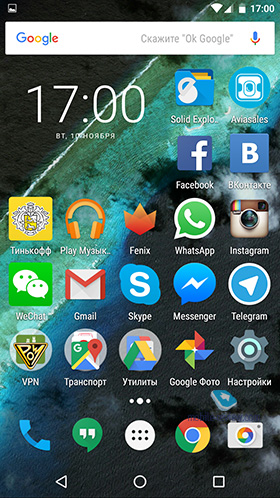
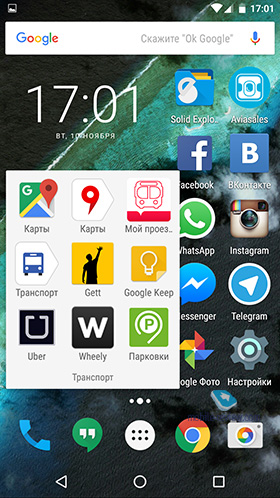

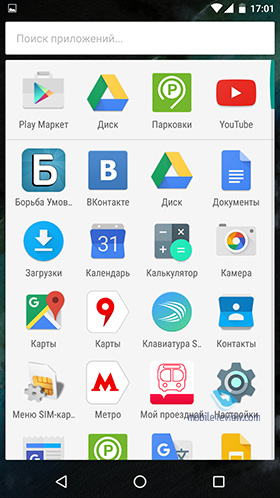
We are already preparing detailed overview Android 6.0 Marshmallow, where all the features of this operating system will be described in detail. For owners of devices on Android 5.1, in fact, there are not many visible changes here. Power optimization has been improved, new app permissions have been added and other things, but in general, this is a familiar Android.


R'RöRґR¶RµS‚ RѕS‚ SocialMart
Conclusion
I had no complaints about the quality of signal reception for a week of using the LG Nexus 5X. The loudspeaker volume is slightly above average, in most situations the incoming call is heard well. The speaker volume is also on good level, there is a small margin for conversations in noisy rooms. The vibrating alert is average in strength.
official cost LG Nexus 5X in Russia is 35,000 rubles (34,990) for the version with 16 GB of memory and 38,000 rubles (37,990) for the version with 32 GB. Here it should be noted that the device competes, oddly enough, with another LG smartphone - the flagship G4. Don't look at the fact that the Nexus 5X has a smaller screen size. In general, the devices are similar in terms of dimensions, as well as in most characteristics and price, so why not compare them? On the side of the LG G4 is the presence of a slot for a memory card, a more interesting (I'm not saying better) design, a removable battery, higher screen resolution and diagonal, 3 GB of RAM and a more versatile camera that allows you to take pictures with natural, natural colors and the ability to further processing them (especially if you shoot in manual mode in RAW). At the same time, the LG G4 is 2,000 or 5,000 rubles more expensive, depending on which version of the Nexus 5X to compare with.

On the side of the LG Nexus 5X is the presence of a fingerprint scanner, albeit a little, but still more compact dimensions, a camera that allows you to immediately get beautiful and well-processed smartphone software images and, most importantly, a clean Android 6.0 Marshmallow operating system with the ability to be one of the first to update it in the future to new versions. Of course, the option of buying a smartphone for $380 in the US (25,000 rubles) looks more pleasant, and with such a price, this smartphone turns out to be more attractive, but we are now talking about Russian realities. I liked the LG Nexus 5X. I can’t say that the device is incredibly cool and that it caused me a lot of emotions, this was not the case. This is just a solid smartphone, balanced in terms of characteristics, with necessary set opportunities for those who want to get a pure "android". The main issue regarding the Nexus 5X is the issue of price, and here you need to decide how much you value the Nexus and its advantages over other smartphones.
Android phones today are a “hodgepodge” of motley processors, displays, cases, and, moreover, system shells. Given that Google does not impose a single look and functionality of android phones on manufacturers (if only search, YouTube and a bunch of other services were preinstalled), Android inside many smartphones is shoveled by manufacturers beyond recognition: in Samsung, the system looks one way, in Huawei it’s different, in ASUS it’s the basis was rethought somehow in a new way, etc.
As a result, the opinion about Android itself is formed, as in the old joke, where Caruso is considered mediocre, because "Izya sang his songs to me yesterday, and I didn't like something." This is partly why Google from time to time organizes an "exhibition of achievements of the android economy" and releases devices on its own. new version No frills Android with some brand new features.
Nexuses (this is the name of this family of gadgets) were almost never released as record-breaking powerful devices of their time. Smartphones of this family have always been slightly weaker than the flagships, however, due to constant improvements and updates, Android remained relevant longer than the flagships of the promoted android phone creators. Because the current giants new versions of Android come out occasionally and only as a gesture of the greatest indulgence. In such a simple way, the Nexuses stand out against the background of the gray mass. After all, no matter how beautiful a woman may be, a personal platoon of cosmetologists and plastic surgeons in old age will definitely benefit her.
Initially, Nexus smartphones flaunted sub-flagship price tags, although in 2014 Google suddenly raged on all the parameters of the triangle (features, dimensions, price), and in the case of Russia, also with the manufacturer. Therefore, Motorola Nexus 6 has remained for us "overseas caviar", existing in the shadow of the iPhone 6 Plus and Galaxy Note 4 in almost all markets.
In 2015, Google decided not to repeat the old mistakes and turned to LG (who came up with the super-successful Nexus 4 and Nexus 5) with the clear intention of restoring the Nexus brand reputation as smartphones that “have it all” + guaranteed upgrade to the latest Android. We have to find out if Google's reference smartphone is worthy of attention at a time when Chinese brands are all-time strong, and market leaders are increasingly updating the version of Android on outdated flagships.
Characteristics
|
LG Nexus 5X (H791) |
|
|
Operating system |
|
|
Screen |
|
|
CPU |
|
|
Graphics |
|
|
Operationalmemory |
|
|
Persistent memory |
|
|
Connection |
|
|
cameras |
|
|
Battery |
non-removable, 2700 mAh |
|
Dimensions |
147x72.6x7.9mm |
|
Weight |
|
|
Price at the time of publication |
38 000 rubles |
|
Price according to dataprice.en |
Design and management
Please get the HTC and Huawei fans off the screens before they start making effervescent jokes about the Nexus 5X's looks. Because the hero of our test is now a rare flagship with a plastic case. Not metal, not glass, but plastic. This detail is similar expensive car without a leather interior, or an apartment without a single carpet inside: the champions of traditional values \u200b\u200bwill definitely resent, even if not everyone understands the gist of the claims. Of the modern smartphone giants, perhaps only Xiaomi still has the courage to release powerful models in a polycarbonate case.
The advantages of this solution are obvious: plastic is a practical and very wear-resistant material. And it also has a beneficial effect on the weight of the smartphone: the Nexus 5X is lighter than competitors such as the Sony Xperia Z5, Huawei Honor 7 and HTC One M9, however, remaining “average” in thickness.
The plastic in the flagship case will outrage many, but the Nexus 5X is lighter and more practical than its pretentious competitors
Of the three options black Nexus looks the most gloomy and budget option, so we recommend paying attention to the "blonds".
It is noteworthy that our hero looks better live than in the photo: the “chubby” rear camera actually protrudes much less than in Huawei Honor 7 or Samsung Galaxy S6, and the smooth contours of the case do not look as strange as the rounded Sony flagships after years of angular design.
The letters "Nexus" and the LG logo are not made "under chrome", but rather under the silver "metallic", as in gel pens. If the inscription turns out to be durable - why not, because this smartphone lacks iridescent and shiny body elements.
True, this is where the pleasant design elements end and the unpleasant ones begin. The front panel of the smartphone, for some unknown reason, is made in the old unkind traditions of HTC: the speakers located on both sides of the display add length to the smartphone out of the blue. And after all, this is not a guarantee of a cool stereo sound, as in HTC smartphones, but just a set of a conversational speaker and a speakerphone, in general, like everyone else. Therefore, in comparison with the Nexus 5 and its incomplete 6 inches, the novelty looks like an excessively corroded phablet, and the diagonal that has grown by 0.2 inches, as well as the LED cunningly mounted in the lower speaker, is little comfort. In the case of the Nexus 5X, this layout has only one plus - the on-screen keys cannot be accidentally pressed, as often happens with Galaxy S6 edge owners. And one more thing - only a cable with USB-C connectors on both sides is supplied with the smartphone, which means that almost all buyers will have to fork out for a “folk” USB-C to USB-A cable, which now costs at least 500 rubles.
The keys on the right side are convenient in themselves, but “mixed up” in places – according to an unspoken rule in new smartphones, the volume swing is located above the lock key. The Nexus 5X is the opposite, so before turning down the volume of the call, the user accidentally locks the display, scolds, and the second time he finds the volume swing. If it's any consolation, we note that the "thigh" volume control is even less convenient to use.
But the fingerprint scanner is damn fast and fits right under the index finger. After registering a fingerprint, it will be possible not to even touch the unlock key - the smartphone is always ready and turns on the desktop in less than a second after touching the sensor with a finger.
True, apart from unlocking, this fingerprint scanner in a smartphone does not yet know how to do anything - it is still very far from the convenience of working with a sensor of the same level as a Google phone. Perhaps Google will mature before being launched in Russia, and then we will pay for purchases in stores with a mobile phone, but this will not happen soon.
Screen and sound
LG is one of the largest manufacturers of TVs, monitors and any custom-made displays, so the quality of the screens remains consistently high almost even in inexpensive models of the brand. And for the “flagship for export”, the Koreans have picked up a very successful matrix.
Yes, a 5.2-inch smartphone has only Full HD resolution, but, by God, we have nothing against such a well-balanced 1080p matrix. The brightness level is about 460 cd / m2 (more than that of the Nexus 5), the color gamut of 97% sRBG and the meager (by the standards of smartphones) DeltaE deviation of 1.9 are very steep indicators for non-professional equipment.
The viewing angles are maximum, the oleophobic coating fights pollution well, and the Gorilla Glass 3 did not pick up scratches during testing. After the Super AMOLED displays and IPS-matrices “raised” in the same vein, it will seem to many buyers that the Nexus 5X display is not saturated enough, but in reality we were simply accustomed to high-pitched “expensive-rich” shades, after which you will have to get used to more reliable color reproduction again.
Full HD resolution is the only drawback of the LG Nexus 5X matrix. Brightness, color reproduction and clarity are commendable
The hands-free speaker in the Nexus 5X disappointed us, to put it mildly. I would like to believe that the problem lies only in a prototype beaten by test operation, and yet our copy of the Googlephone sounded very poor. Compared to the Nexus 5, the new smartphone plays a little quieter, but that's not even the problem. Already at an average volume level, it is noticeable how a dirty, unintelligible sound comes from the speaker, and at the volume limit, it also begins to wheeze intensely if there is an overpowering chorus in the music track.
Of course, the old Nexus 5 cannot be called a music lover's dream either, but only with a two-year-old android phone, the limit beyond which distortions begin appears much later. Most of all, the speakerphone quality of the Nexus 5X is similar to the recessed and dried Huawei Honor 7 – the metal “Chinese” also reproduces the sound carelessly, but it has an impressive volume margin. And the Nexus 5X has all the same problems, but without any "but".
If you accept that this is a rejection of the flagship 810 chip, you will be able to use smartphones on a simplified version of the top Qualcomm without any symptoms of insufficient performance: if in the LG G4 the same chip often worked at high frequencies (branded shells are not given to iron for free) , then in Nexus, which between the “rocking chair” and “weight loss” has always adhered to the second option, the same stuffing works with a good reserve for the future.
A six-core processor is a restless character. It is not able to impose competition on flagship chips, but at the same time it overtakes any middle-class model by a large margin.
Now the power of the “poor relative” of flagship processors is approximately equal to the MediaTek MT6795T or Kirin 930-935 chip that is relevant for Chinese smartphones. That is, our hero a priori will not “jump” to Snapdragon 810, which works at full strength (these are sometimes found) or Exynos 7420 from the Galaxy family, but it is still powerful enough not to be considered a middle-class processor. Let's also not forget that thanks to the efforts of Google programmers, our hero will certainly grow old no later than the HTC One M9 or Sony Xperia Z3 +, and even the mean 2 GB of "RAM" will not prevent him from doing this.
But the ridiculous volume of the drive, of course, looks like a cruel joke from the manufacturer. The 16 GB version with 11 free gigabytes looks especially ridiculous: I recorded one high-quality 720p movie on my smartphone - and there is no more room in it for anything. With a 32 GB drive (which is exactly what we had on the test), the problem is not so acute, but does not disappear completely.
The level of Wi-Fi and 4G reception does not cause the slightest criticism, and navigation is caught quickly and efficiently - in rainy weather, the smartphone “hooked up” to 17 satellites out of 22 visible (GPS and GLONASS) and followed the route with an error radius within 4 meters. Not bad at all!
The smartphone body in games warms up to 42 degrees Celsius in games only near the rear camera and the upper edge of the display, the rest of the body area remains almost room temperature.
Soft
Google paid the innovations of Android 6.0 a minimum of attention even at the time of its launch, and all because the visual differences here will pick up from the strength of the number 5.2. However, after a couple of weeks of use, you notice that a bunch of little things still deserve a separate “tasty” name in the list of Android operating systems.
First of all, cosmetic improvements in the application menu are striking: now the list is scrolled from top to bottom (it will be interesting to see what Xiaomi and other fans of redrawing Android will now “collectively farm” in a special way), and the application search bar has appeared on top, and just below it is four most frequently used software.
Android 6.0 does not feel new, but in every possible way "improved and supplemented" 5.0 Lollipop
From now on, the power saving mode can be applied to individual impudent and gluttonous programs (we will also include requests for access to contacts, SMS and the Internet “on demand”, and not at the first installation of the program). The Active Display feature turns on the clock display for a couple of seconds and immediately turns them off after you take your smartphone out of your pocket.
Fans of optimizing everything in the world now have a menu with a detailed report on the use of RAM by programs. For dessert - payment for purchases from the phone, which is not supported in our area, an Internet search that can guess what you need from the text on the screen (also does not work in Russia), as well as a more careful attitude to the battery in standby mode.
For the sake of the record, we note that an early prototype came to us for testing, in which, before loading the system, the bootloader cursed at non-standard firmware. The firmware, apparently, was intended for Android developers - for their benefit, the Volta and QXDM logger worked in the ROM. In short, the software was not quite standard, but we were unable to identify any software flaws and bugs during use. Standard applications to a minimum - and then the owner of the Nexus should go to Google Play and equip the smartphone to your taste.
cameras
Even the camera in the new Nexus is on par with the concept of the device - yes, at first glance it seems that “there weren’t enough megapixels”, and you don’t expect anything extraordinary from a 12 megapixel sensor. But it’s not the quantity that matters, but the quality: a seemingly banal camera operates with 1.55 nm pixels (large pixels allow you to get rid of blurring in the frame), boasts an aperture of f / 2.0 (more light, less noise in the photo), laser autofocus (quickly aims objects) and powerful flash. And, surprisingly, all this piling up works smoothly in practice.
The camera controls are simplified to the limit: clicked - photographed. Unless you can activate HDR, a timer and a flash without additional hassle. By the way, you can turn on the camera from the locked state of the smartphone by double-clicking on the lock key. There is no optical stabilization in the camera, Google claims that with such sensor characteristics, there will be no problems with image clarity a priori.
The camera and its "brains" in the Nexus 5X worked flawlessly - good pictures are obtained without preparation and tricky settings
The Nexus 5X takes good pictures - laser autofocus quickly monitors the situation in the frame, and overexposure, or vice versa, the dark time of the day does not become an obstacle for the camera. You can only find fault with the excessive “combing” of the final frames: take a look at a photo of a cat and evaluate how photo processing algorithms turned a potentially “noisy” indoor shot into a photo with slightly degraded object detail, but good quality generally.
On the one hand, smart automation does a hell of a job with night shooting, especially since it would be too troublesome to bring to mind a crooked night shot manually. On the other hand (let's nitpick to the end) - with this approach, the level of sharpness in pictures with good lighting does not reach the results demonstrated by the LG G4 / Samsung Galaxy S6.
With video shooting, things are also not bad - the Nexus 5X is able to shoot video in 4K resolution at 30 fps, 1080p at 60 fps and 720p at 120 fps. To be honest, optical stabilization is still a bit lacking, and holding the smartphone while shooting on the go will have to be done.
The quality of the front camera (if you do not take into account a separate cast of selfie smartphones) is also at the flagship level.
autonomy
The truncated potential of the Snapdragon 808 did a good job for the hero of our test - contrary to the preliminary fears and the negative experience of our colleagues, we did not find any problems with the duration of work in the Nexus 5X. Of course, a 5.2-inch smartphone should be equipped with a battery with a capacity of at least 3000 mAh, but our Nexus manages the available 2700 mAh quite reasonably.
It seems that fancy games in the case of the “808th” processor were destined to spin on only two Cortex-A57 cores, but even so, autonomy that surpasses Huawei Honor 7, Sony Xperia Z5 and Samsung Galaxy Note 5 is worth it.
The quieter you go, the further you'll get. Two cut cores from the processor and a lightweight Android variant make up for the modest battery capacity
In other modes, the smartphone also did not hit the dirt with a display - competitors based on AMOLED matrices will, of course, be ahead, but as for a smartphone based on a loser processor, LG Nexus 5X demonstrates excellent results even without activating the power-saving mode.
It is a pity that, contrary to numerous rumors, the hero of our test does not support Qualcomm Quick Charge - for top speed Charging recharge your smartphone battery with a 2A charger for 1.5 hours.
Competitors
|
LG Nexus 5X (H791) |
Samsung Galaxy S6 |
Sony Xperia Z3+ |
|
| > | |||
|
Operating system |
Android 5.1 Lollipop |
Android 5.1 Lollipop |
|
|
Screen |
5.2 inches, 1920x1080, IPS, 423 ppi |
5.1 inches, 2560×1440, Super AMOLED, 577 ppi |
5.2 inches, 1920x1080, IPS, 423 ppi |
|
CPU |
Qualcomm Snapdragon 808 MSM8992 1.8GHz (6 cores, 4x Cortex-A53 + 2x Cortex-A57) |
Samsung Exynos 7420 2.1GHz (8 cores, 4x Cortex-A53 + 4x Cortex-A57) |
Qualcomm Snapdragon 810 MSM8994 2.0GHz (8 cores, 4x Cortex-A53 + 4x Cortex-A57) |
|
Graphics |
|||
|
Operationalmemory |
|||
|
Persistent memory |
32 GB, Micro SD slot |
||
|
Connection |
4G (LTE Cat.6), 3G, Wi-Fi 802.11 (IEEE 802.11 b/g/n/ac), Bluetooth 4.2, GPS, GLONASS, NFC |
4G (LTE Cat.4), 3G, Wi-Fi 802.11 (IEEE 802.11 b/g/n/ac), Bluetooth 4.0, GPS, GLONASS |
4G (LTE Cat.6), 3G, Wi-Fi 802.11 (IEEE 802.11 b/g/n/ac), Bluetooth 4.1, GPS, GLONASS, NFC |
|
cameras |
12.3 MP - main, with autofocus, video 3840x2160, front - 5 MP |
16 MP - main, with autofocus, video 3840x2160, front - 5 MP |
main: 20.7 MP, with autofocus, video 3840x2160, front: 5 MP |
|
Battery |
non-removable, 2700 mAh |
non-removable, 2600 mAh |
non-removable, 2930 mAh |
|
Dimensions |
147x72.6x7.9mm |
142×70×67 mm |
146.3x71.9x6.9mm |
|
Weight |
|||
|
Price at the time of publication |
38 000 rubles |
38 000 rubles |
40 000 rubles |
|
Price according to dataprice.en |
Request a Quote: LG Nexus H791 2801 1 |
Request a Quote: Samsung Galaxy S6 2801 1 |
Request a Quote: Sony Xperia Z3+ 2801 1 |
conclusions
The decision to buy the hero of our test depends on the answer to the question: what is Nexus in your understanding? In Russia, such devices are considered an act of charity by Google. Say, the search engine out of kindness forced LG/HTC/Samsung/Huawei/Motorola to produce smartphones with outrageous characteristics cheaper than flagships from any other manufacturer. And if we consider the history of Googlephones up to the Nexus 5 model, such reasoning will not be without meaning.
But, starting from 2014, this interpretation is no longer relevant. It makes no sense to look at prices in the US (if only because they do not include mandatory US taxes), and the European €480 for a model with 16 GB of memory is comparable to the Russian 35 thousand. And you need to be a devout fan of Google in order not to notice the abundance of alternatives for a comparable amount in Russian retail.
For example, LG G4 (yes, it's a phablet, so what?) Today you can easily buy it for 30 thousand rubles. Or even prefer the model at the official price - 39 thousand rubles. Indeed, for a thousand rubles additional payment, compared to the Nexus 5X, you will receive a smartphone with a much more stylish design, a memory card slot, a removable battery and a better display. Even the mediocre autonomy and reduced gaming performance of the G4 do not justify the inflated price for a new product from Google. Not to mention the fact that lovers of 5-5.2 inch smartphones can safely purchase the cheaper Samsung Galaxy S6 in Russian retail, and are unlikely to be disappointed.
The most annoying thing is that the smartphone itself is quite good! Lightweight body, very high-quality camera, fast and energy efficient Android 6.0, amazingly smart fingerprint scanner and advanced display. All this pleases and inspires, but not for 38 thousand rubles. Therefore, without adjusting the price tag, a smartphone that is remarkable in terms of the sum of its qualities threatens to remain an “unrecognized genius” on the Russian market.
One way or another, the younger Nexus retained the proprietary lightness of the operating system and the impressive speed of work, so we recommend this model for purchase to anyone who is tired of clumsy, gluttonous and stuffed to the eyeballs with software android phones.
The 2013 Nexus 5 is considered by many users and journalists around the world to be the best in the line. This model perfectly combined the top-end stuffing at that time, neat design and affordable price. Last year's Nexus 6 could boast of features and appearance, but its size and cost were, to put it mildly, not for everyone.
This year, Google released two models at once. The older model in the face of Huawei Nexus 6P, like last year's device, has a large display and the price is at the level of flagships from A-brands. The second smartphone can be called the heir to the 2013 model, LG Nexus 5X is quite compact, and powerful hardware stuffing and relatively low price make it a contender for the title of people's smartphone in 2015.
Packaging and equipment
The packaging of the LG Nexus 5X is compact and neat, according to the established tradition of images and Technical information applied not on the box, but on a kind of cardboard apron.

The package includes: a smartphone, a charger, documentation, a paperclip to open the SIM tray and a synchronization cable. For the latter, both plugs are type C; to connect to a PC, the user will have to buy a separate cable.
Appearance and ergonomics
The design of the smartphone is deliberately simple. The case is made of plastic with soft-touch coating, it is covered with Gorilla Glass 3 in front. Controls, connectors and camera module are conveniently located.
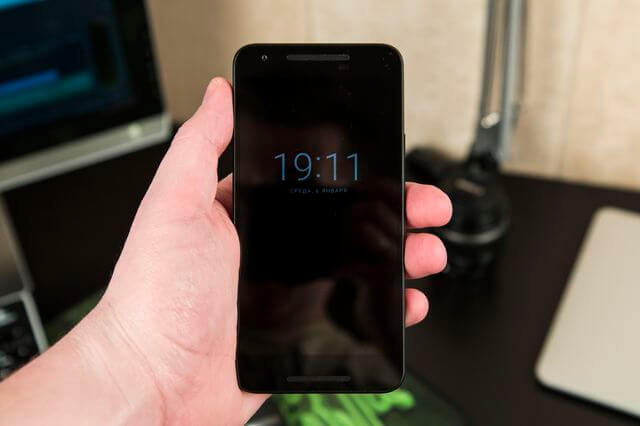
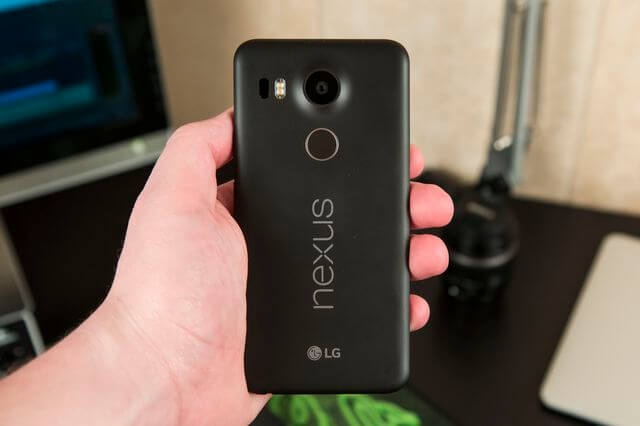




Like the older model Nexus 5X is equipped with a fingerprint scanner, it is located under the main camera. This arrangement cannot be called successful, firstly, the smartphone lying on the table cannot be unlocked. Secondly, some skill is needed in order to get your finger into the scanner without looking. A very good solution is the ability to start the camera by double-clicking on the power button.
Screen
LG Nexus 5X is equipped with a 5.2-inch screen with a resolution of 1920 * 1080 pixels. There are no questions about the quality of the screen, the brightness and contrast indicators are at a good level, and the color reproduction feels more natural than on AMOLED screens.

An effective anti-reflective layer allows you to use your smartphone even in direct sunlight. The touch screen detects up to 10 touches simultaneously.
Hardware platform and performance
The positioning of the device imposes some restrictions, including on the characteristics. The hardware platform is Qualcomm's top, but not the most powerful SoC: Snapdragon 808 (MSM8992) and only 2 GB of RAM. The system-on-a-chip includes two “strong” Cortex-A57 cores, four “weak” Cortex-A53 cores and an Adreno 418 video core. The internal memory can be 16 GB or 32 GB, there is unfortunately no memory card slot. In the younger modification, 10.6 GB is available for user needs.


In AnTuTu v6.0, the smartphone scores 62392 points, in the Geekbench 3 single-core test - 1205 points. Practical performance is at the expected high level and is sufficient for solving any problems. Some specialized publications note a noticeably lower speed of the graphical interface compared to Nexus 6P and even Nexus 5, explaining this by default data encryption. In real life, if you do not compare devices head-on, there are no problems with the response speed and interface rendering.
Cellular and interfaces
The smartphone works in LTE networks including bands: B3, B7, B20 and B38 - i.e. supports all frequencies used by Russian mobile operators. The list of supported wireless interfaces includes: Wi-Fi 802.11 ac, Bluetooth 4.2 and NFC. The wired interface, despite the type-C connector, complies with the USB 2.0 standard.

Battery and autonomy
The smartphone has a non-removable 2700 mAh battery, fast charging technology is supported: from 0% to 100% the battery will be charged in just an hour and a half (from 0% to 75% in 50 minutes). Unlike its predecessor, the Nexus 5X does not support wireless charging. The autonomy of the smartphone is average, in a mixed mode of operation, the Nexus 5X will work from morning to late evening with 3.5-4 hours of screen activity. Testing in typical operating modes did not show anything unusual.
Note. Testing is carried out in the appropriate modes according to the methodology: - listening to music in headphones at maximum volume with the screen turned off; – viewing 720p video from the device’s memory at 50% backlight brightness and maximum sound volume in headphones; - active browsing (constant opening of new tabs, active page scrolling, etc.) via Wi-Fi at 50% backlight brightness; – 3D games ( Real Racing 3) at 50% backlight brightness.
Cameras, photo and video quality
The main camera of the LG Nexus 5X is a fairly large 1/2.3” sensor with a resolution of 12 MP, covered by a lens with an aperture of F2.0 and an equivalent focal length of approximately 28 mm. There is no manual mode in the system camera, but the corresponding API allows a third-party application to access any settings.
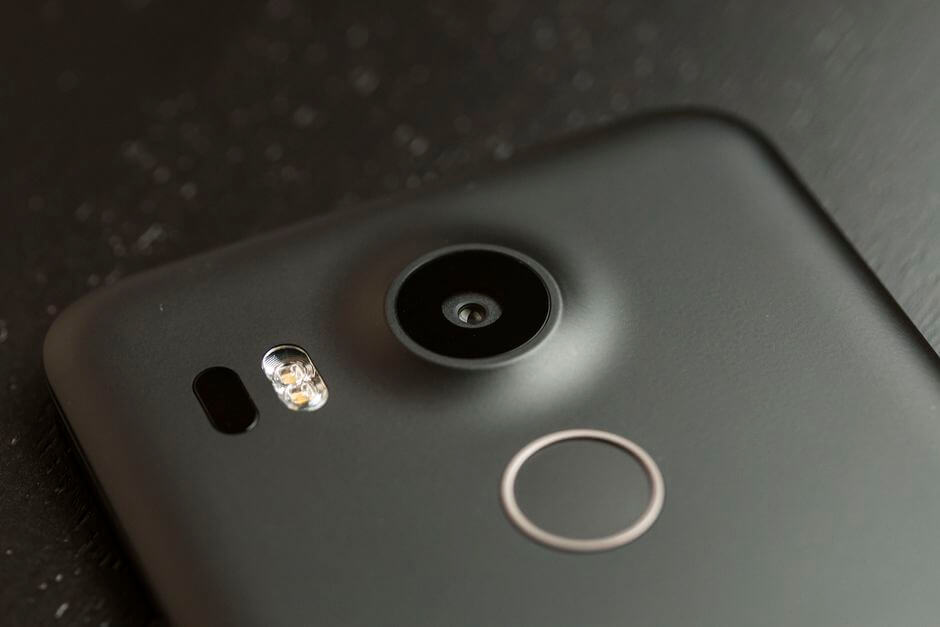
Under conditions of sufficient natural light The Nexus 5X camera captures images with a high level of detail and a relatively wide dynamic range. Software sharpening sometimes produces too much sharpness. CLICKABLE! On the left is a shot of LG Nexus 5X, on the right is an Apple iPhone 6s Plus:
 |
 |
 |
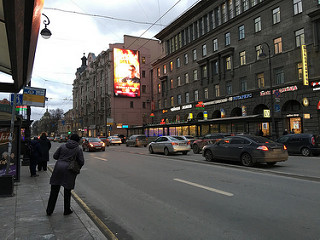 |
 |
 |
 |
 |
 |
 |
 |
 |
 |
 |
 |
 |
 |
 |
In HDR+ mode, the dynamic range is even wider, and details that were previously either overexposed or underexposed appear in photos. This mode is recommended for use not only in high-contrast scenes, but also in any difficult shooting conditions. CLICKABLE! On the left is an HDR shot of the LG Nexus 5X, on the right is an HDR shot of the Apple iPhone 6s Plus:
 |
 |
 |
 |
 |
 |
 |
 |
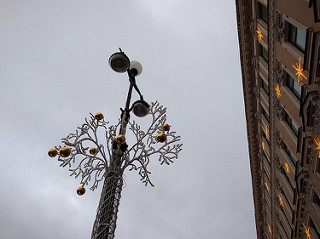 |
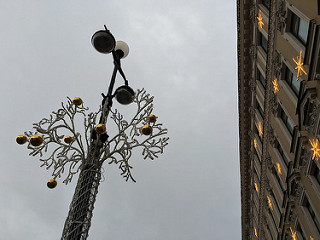 |
 |
 |
 |
 |
 |
 |
In conditions of insufficient or artificial lighting, the smartphone camera showed its best side: most of the details are preserved, the noise reduction works very delicately, and the white balance is almost always accurate. The result becomes even better if you activate the HDR + mode. CLICKABLE! On the left is a non-HDR shot of the LG Nexus 5X, in the center is an HDR shot of the LG Nexus 5X, on the right is a non-HDR shot of the Apple iPhone 6s Plus:
 |
 |
 |
 |
 |
 |
 |
 |
 |
 |
 |
 |
 |
 |
 |
Panoramic shooting mode in the Nexus 5X is well implemented. Photopano in most situations does not have gluing artifacts and exposure problems, the frame has good sharpness across the entire field, the final image has a resolution of more than 40 megapixels. CLICKABLE! Top panorama shot on LG Nexus 5X, bottom panorama shot on Apple iPhone 6s Plus:


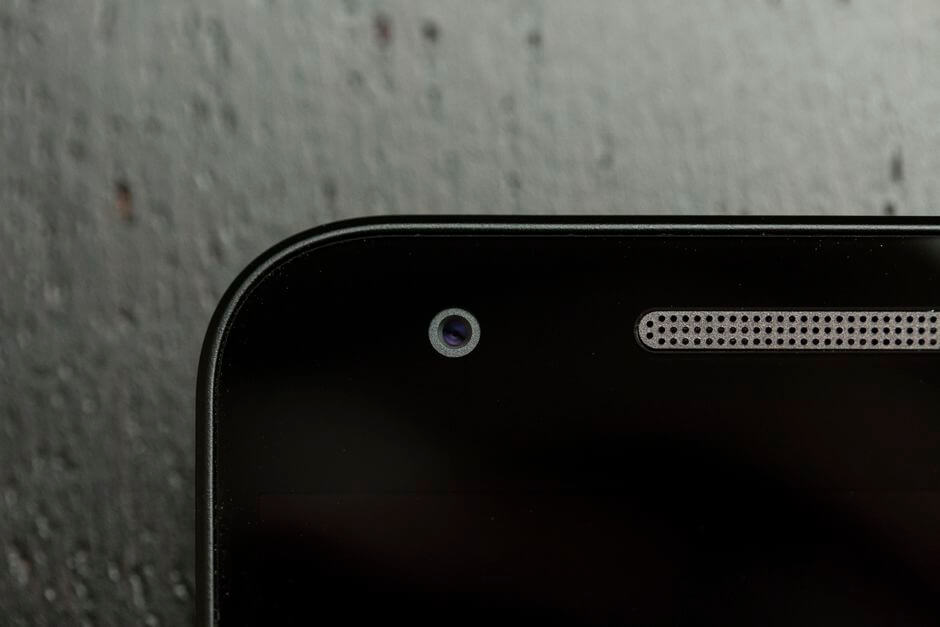
The 5-megapixel front camera is covered by a lens with an aperture of F2.0 and an equivalent focal length of approximately 26 mm. Can capture video in FullHD resolution. Photos taken on the front camera are very good. CLICKABLE!



![]()

Video smartphone writes at a maximum resolution of 3840 * 2160 pixels at 30 fps with stereo sound. For the most part, there are no complaints about the picture quality, except that the dynamic range could be wider. When shooting handheld, due to the lack of optical stabilization, the image most often turns out to be twitchy. There is a mode four times slow motion in HD-resolution at 30 fps and with sound.
Sound quality
When looking at the front panel of the Nexus 5X, it may seem that there are two external speakers in it, but this is not so. The only ringing speaker is located under the screen, it plays uninterestingly and quietly, low frequencies are almost completely absent in the sound.
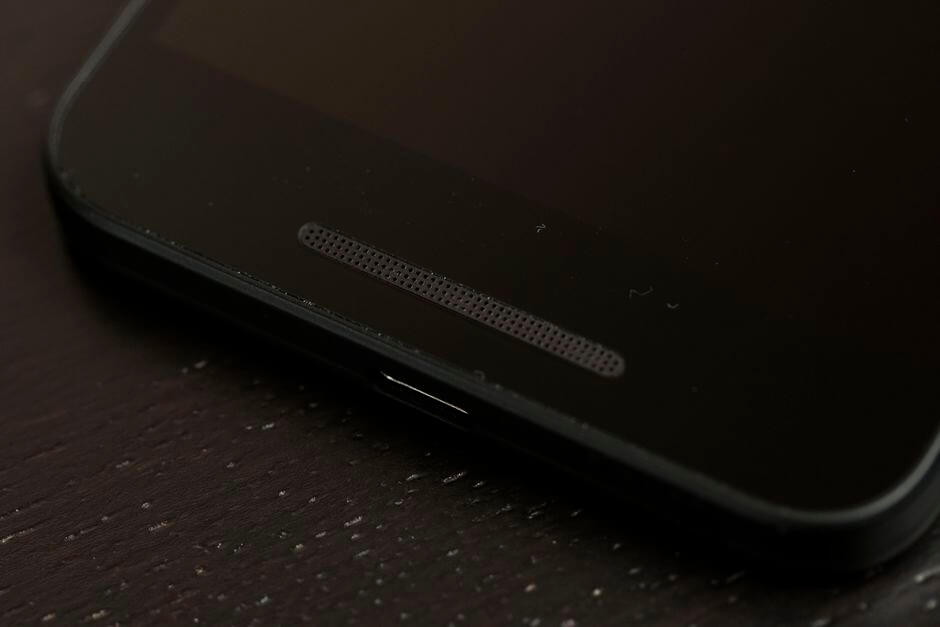
It's no secret that Google does not manufacture smartphones on its own, but does it together with partner companies. Initially, the Google Nexus line meant the creation of affordable devices with top features for software developers, but later they found popularity among ordinary users, as they made it possible to quickly receive updates to the current version of the Android OS. But with the advent of Motorola Nexus 6, the situation has changed somewhat, and price policy has become on par with flagship smartphones from other manufacturers. The same concept was continued by last year's Huawei Nexus 6P. True, in parallel with it, an update of this bestseller appeared. The smartphone even got a similar name, LGNexus 5 X, and kept a close price tag.
Let's figure out together what has changed over the past few years and how interesting the device turned out to be for a wide audience.
Specification
|
Manufacturer and model |
H791) |
|
|
Type, form factor |
Smartphone, monoblock |
|
|
Communication standards |
850 / 900 / 1800 / 1900 MHz |
|
|
900 / 2100 MHz |
||
|
800 / 1800 / 2600 MHz (ranges 3, 7, 20) |
||
|
High speed data transfer |
GPRS (32-48 Kbps), EDGE (236 Kbps), HSDPA (up to 42.2 Mbps), HSUPA (up to 5.76 Mbps), LTE cat.4 (up to 150 Mbps) ) |
|
|
CPU |
Qualcomm Snapdragon 808: 2 x Cortex-A57 @ 1.44GHz + 4 x ARM Cortex-A53 @ 1.82GHz |
|
|
Graphics adapter |
Qualcomm Adreno 418 |
|
|
5.2", IPS, 1920 x 1080 (423 ppi), touch, multi-touch up to 10 touches, protective glass Corning Gorilla Glass 3 |
||
|
RAM |
||
|
Persistent memory |
||
|
Interfaces |
1 x USB 2.0 Type-C (OTG) 1 x 3.5mm mini-jack audio jack |
|
|
Multimedia |
Acoustics |
|
|
Microphone |
||
|
Main |
12.3 MP, Sony IMX377 module, f/2.0 aperture, laser autofocus, dual LED flash, 4K Ulta HD video recording |
|
|
Frontal |
5 MP, f/2.0 aperture, fixed focus, 1080p video recording |
|
|
Networking |
Wi-Fi 802.11a/b/g/n/ac (2.4/5 GHz), Bluetooth 4.2, NFC, GPS (A-GPS), GLONASS |
|
|
Fingerprint scanner, accelerometer, gyroscope, proximity, ambient light, pressure, digital compass, Hall sensor, notification LED |
||
|
Battery |
Lithium-ion, non-replaceable (2700 mAh) |
|
|
Charger |
Input: 100~240V AC e.g. at 50/60 Hz Output: 5V DC e.g. 2 A |
|
|
147 x 72.6 x 7.9mm |
||
|
Black / White / Mint |
||
|
Operating system |
||
|
Official guarantee |
12 months |
|
|
Products webpage |
||
Appearance, arrangement of elements


If we compare the LG Nexus 5X with the progenitor in the face, then the design has become much simpler and more neutral. The rounded top and bottom ends are flat, but with noticeably rounded corners, like most modern smartphones. The ceramic control keys were replaced with plastic ones, and the original round earpiece acquired an oblong shape. But, as before, this is a non-separable monoblock made of polycarbonate and glass. The usual black and white color scheme was diluted with a pleasant mint shade. Despite the simplification appearance, the device looks quite nice, but it lacks a certain personality.

The dimensions of the device have grown significantly (147 x 72.6 x 7.9 mm versus 137.84 x 69.17 x 8.59 mm), especially in height: by increasing the diagonal by 0.2 inches and transferring the multimedia speaker to the front panel . The frames around the screen are not the smallest: 15 mm on top, 16.5 mm on the bottom and 3.5 mm on the sides. However, the width has not changed much, and the thickness has decreased slightly. In any case, the smartphone is light, fits perfectly in the hand and is conveniently operated even with one hand.


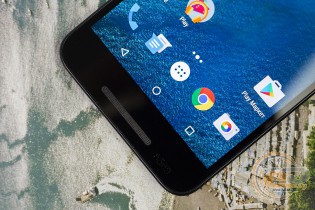
The front side of the LG Nexus 5X is covered with a protective glass with small sides, but without any logos. The main innovation is symmetrically placed speaker slots, as in some Motorola or HTC models. Unfortunately, this is not a stereo pair, but only conversational and multimedia speakers. In addition, there are a number of familiar elements: proximity and light sensors, a camera eye and an interesting solution with an integrated notification sensor under the lower speaker grille. Onscreen keys.
On the bottom edge there is a symmetrical USB 2.0 Type-C port, a microphone and a 3.5 mm audio port, while the top one is reserved only for an additional microphone. The mechanical hardware keys are located on the right side face, and the Nano-SIM SIM card slot is on the opposite side. But if most smartphones have a volume rocker located above the power / lock key, then the opposite is true, and you need to get used to it.
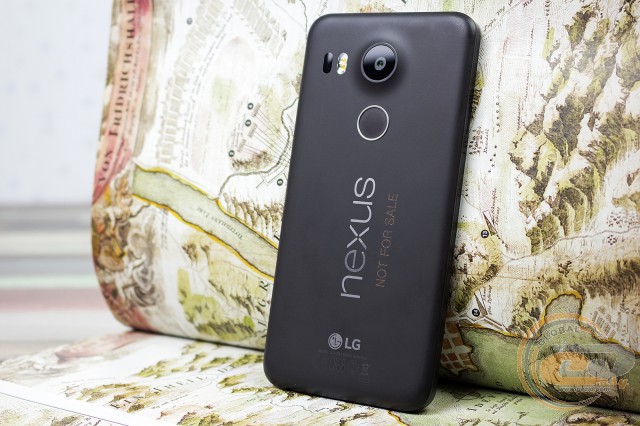

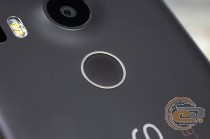

The back of the LG Nexus 5X has a pleasant, albeit easily soiled, soft-touch coating in the black version. At the top is a protruding main camera module with laser autofocus and dual flash, and below it is the Nexus Imprint fingerprint sensor. Even lower is the Nexus inscription, which is now simply printed, and not made with an insert, like the previous five, and, of course, the LG logo.
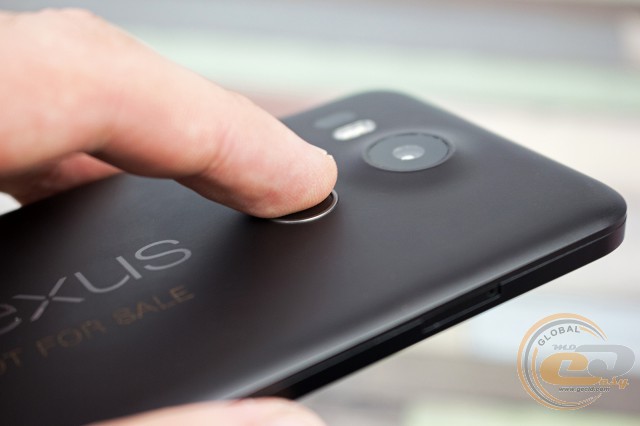
The location of the fingerprint scanner is convenient for most cases. Taking the smartphone out of the pocket, the index finger exactly rests on it, but lying on the table with the screen up - this trick will not work. It works very quickly and accurately - here full order.
The build quality of the tested model is simply remarkable: the parts fit well, without any hint of play and third-party sounds during operation.
Display
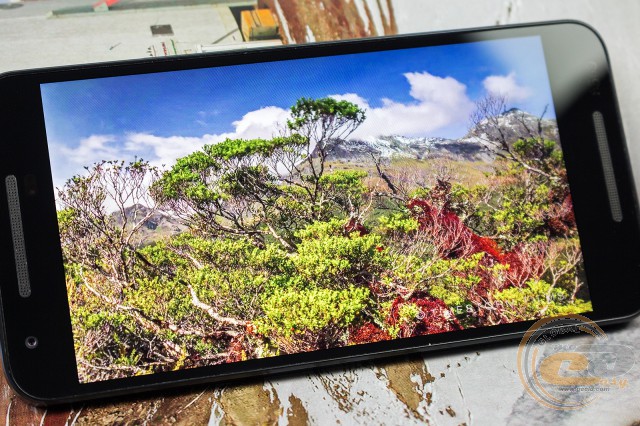
The LG Nexus 5X has a proprietary 5.2-inch IPS-matrix screen with a resolution of 1920 x 1080 and a pixel density of 423 PPI. The diagonal has grown a little compared to , but the resolution remains the same. Yes, this is not a 2K display, which is already familiar to many Android flagships, but it is more than enough for any tasks. In addition, less load is placed on the system. To protect the matrix, Corning Gorilla Glass 3 is used with an effective oleophobic layer and a high-quality anti-reflective filter.

The overall impressions of the screen are the most positive: natural colors, excellent contrast, uniform backlight and maximum angles review. The brightness adjustment range is sufficient for comfortable work on a sunny day or in complete darkness, although the minimum value could be smaller. Automation works quite adequately - without jerks and hitches.
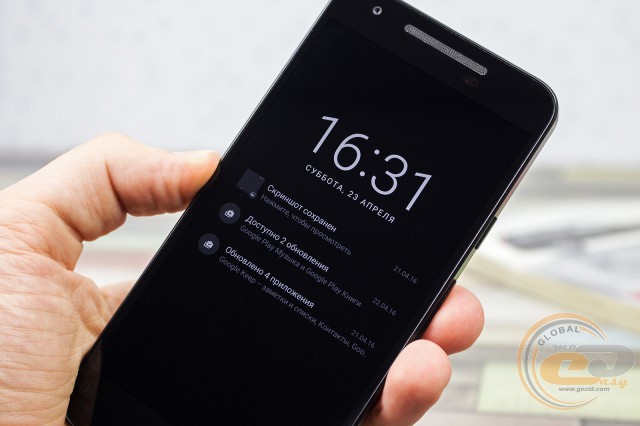
The Ambient display feature activates the device's display when you pick it up. Multi-touch technology handles up to 10 simultaneous touches. Both are functioning properly.
Audio subsystem

Like its predecessor, LG Nexus 5X is equipped with one multimedia speaker, which has moved from the bottom to the front panel. It is loud enough not to miss a call in a crowded place. The frequency range is quite pleasant throughout the volume range, but without any frills. To perform basic functions (games, video and speakerphone), its capabilities should be enough.
The package of the tested model does not include a headset, so the sound in the headphones was tested using gaming headphones (impedance 60 ohms) and in-ear Vivanco HS 200 WT (impedance 16 ohms). In both cases, the sound is pleasant to the ear, but nothing special stands out from the background of most Android devices. The volume level is sufficient (there is a minimum margin). Sound settings are limited only by the equalizer built into the Google Play Music audio player. The smartphone does not have an FM radio.
Camera

The main camera received a 12.3-megapixel Sony IMX377 (1 / 2.3 ") module, which can be found in compact cameras, laser autofocus (rangefinder), dual CRI-90 LED flash and the ability to record video in 4K Ultra HD (30 FPS) Compared with , the increased resolution is striking, therefore, detail has also improved. The pixel size on the matrix has grown from 1.4 to 1.55 microns. The lens aperture has also increased to f / 2.0, which allows the camera to capture much more light. The only disappointing thing is the lack of optical stabilization, which would be useful to help remove micro-shaking of hands when shooting.
In any case, the camera turned out well, it is almost in no way inferior to modern flagship smartphones. It captures beautifully both during the day and at dusk. The resulting frames are pleasing with excellent sharpness and a bright palette with the right white balance. The dynamic range is quite wide, including due to the proprietary HDR + mode, which now works noticeably faster (but depends on the situation). In addition, it became possible to shoot good slow motion video in 720p at 120 FPS and decent 1080p, but only at 30 FPS. To quickly launch the camera, you can use a double-click on the power key.
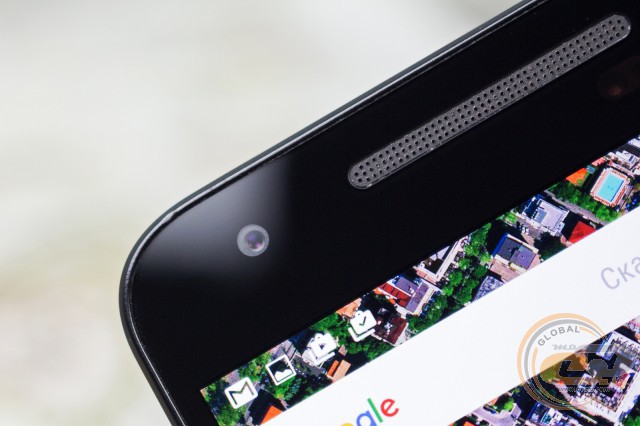
The front camera has a 5-megapixel module, fixed focus, lens with f / 2.0 aperture and a wide viewing angle. The quality of the photo and video materials is very good. Notably, it now also supports HDR+ mode.
The camera app has updated look. As before, it is visually pleasing and easy to use, but it has a meager set of modes and manual settings. There is no possibility to fully control the shooting process, as well as shoot in RAW. Fortunately, advanced users can always use third-party software.
Examples of photo and video shooting
An example of slow-motion daytime shooting from a smartphoneLG Nexus 5 X in resolution 720pat 120 FPS
Smartphone daytime exampleLG Nexus 5 X in 1080p at 30 FPS
User interface
Perhaps the main advantage of all devices in the Google Nexus line is the use of the latest version of the Android OS in its original form, without any launchers and add-ons.
Our copy of the LG Nexus 5X runs Android 6.0 Marshmallow with a further upgrade to a future version of Android N. Despite minimal visual differences from Android 5.x.x Lollipop, there are enough internal functional changes. Let's briefly go through the main innovations.
Outwardly, we have a nice design in the Material Design style with some slightly changed fonts and animations. You can now delete applications directly from the desktop, and not just shortcuts, as it used to be.
In the notification shade, the order of the icons has changed, and the “System UI Tuner” add-on has also been added, which is called by holding the gear image. With it, you can change the contents of the quick settings panel, manage application notifications in the status bar, and activate the battery percentage indicator.
The application menu has received vertical scrolling; program icons are sorted alphabetically, but without the possibility of grouping by folders. But at the top there is always a search bar for applications, and below it are the four most frequently used programs.
A really useful feature in everyday life is separate volume control in different applications. It is also worth remembering the appearance of the Do Not Disturb functional mode, which allows you to flexibly customize the notifications you receive or turn them off completely while maintaining the ability to call.
One of the most interesting innovations is the Google Now on Tap feature, which analyzes the content of the active area on the screen (web pages, messages and other applications) and generates various suggestions based on the context. This is quite convenient, for example, we listen to a song or watch a video, hold down the "Home" key and get links to the author, interesting pages in in social networks and a lot of other useful information.
The settings also have new items and features. Each application can be allowed or denied access to certain data on your device (contacts, calls, messages, Internet, and so on) and opening links. The "Storage and USB storage" item shows detailed information about the use of internal and external memory, and also contains a built-in file manager with basic functionality. The item "Battery" shows not only a graph of the use of the battery charge, but also the approximate consumption in mAh. In the Battery Saver section, you can customize how apps work to extend battery life. Doze technology automatically activates to optimize power consumption when your device is idle. It blocks notifications from applications, except for priority ones.
The OS runs quickly and very smoothly, without any hint of hitches or slowdowns. It could not be otherwise - the optimization is just excellent.
Performance and connectivity
The LG Nexus 5X is based on a 6-core Qualcomm Snapdragon 808 SoC. It is based on a 20nm process and includes two high-performance ARM Cortex-A57 cores with a frequency of up to 1.44 GHz and four energy-efficient ARM Cortex-A53 cores with a frequency up to 1.8 GHz. Responsible for the graphics Qualcomm Adreno 418 with an operating clock speed of 600 MHz and support for API OpenGL ES 3.1, OpenCL 1.2 and DirectX 11.2. The amount of LPDDR3 RAM is 2 GB, and the permanent memory is 16 GB, of which about 10.67 GB is available to the user. Traditionally, for the Google Nexus line, there is no way to use memory cards, but you can connect external USB devices thanks to support for OTG (USB On-The-Go) mode.
According to the results of synthetic tests and real experience operation, the performance of the smartphone is very high. It is at the level of competing solutions with HiSilicon Kirin 935 and MediaTek MT6795 on board. Yes, this is not the top-end Qualcomm Snapdragon 810 or Samsung Exynos 7420, but in everyday life you almost don’t feel the difference: the OS, any applications and demanding games work perfectly, including at high graphics settings, but it depends on the optimization of a particular game. For example, Asphalt 8: Airborne works great at maximum settings, but in WoT Blitz it is better to play at medium settings to avoid short-term FPS drops when the scene is saturated with explosions and smoke. Only the presence of 2 GB of RAM is upsetting: for now this is enough, but there is no reserve for the future. The rest is in order. Even under prolonged load, the smartphone body becomes a little warm around the camera.

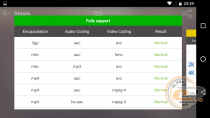
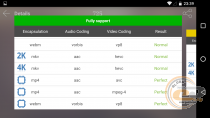
The built-in video player has good support for modern audio and video formats, as evidenced by the results of the Antutu Video Tester benchmark.
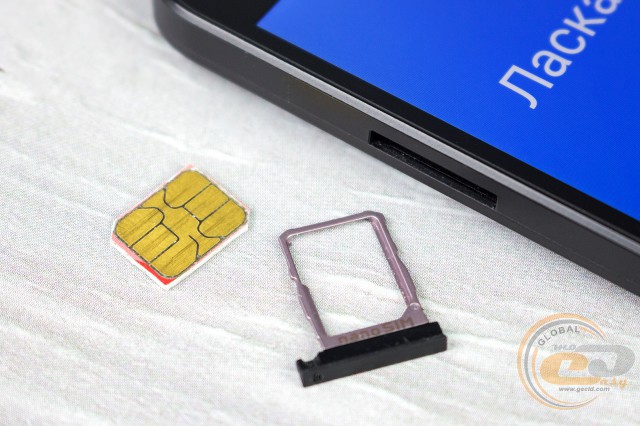
LG Nexus 5X supports modern 2G GSM, 3G UMTS and 4G LTE Cat.4 mobile networks. There is only one radio module, just like the number of SIM cards. Everything is functioning properly. The speaker and microphone perform well. The vibrating alert is average in strength, but the timbre is a bit like the buzzing of a mosquito.
Communication capabilities are presented with everything you need: NFC, Bluetooth 4.2 and Wi-Fi 802.11a/b/g/n/ac. The latter has support for Wi-Fi Direct and Wi-Fi Hotspot functions and is capable of operating in two bands (2.4 and 5 GHz).

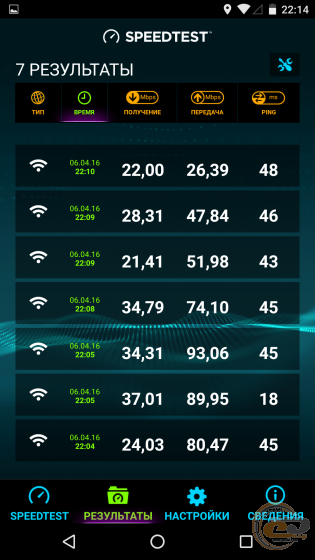
When testing problems in the operation of wireless modules, no problems were noticed.



The navigation module is characterized by the support of GPS (A-GPS) and GLONASS systems. Cold start takes about 5 seconds.
Offline work
The capacity of the non-replaceable lithium-ion battery is 2700 mAh, which is 400 mAh higher than the average five. A full charge of the battery is enough for 1.5 days of battery life in conditions medium load with several hours of display operation (calls, SMS, music, some Internet). With economical use, this figure can be stretched to two days. In general, the autonomy of the LG Nexus 5X is at the level of most modern Android smartphones.



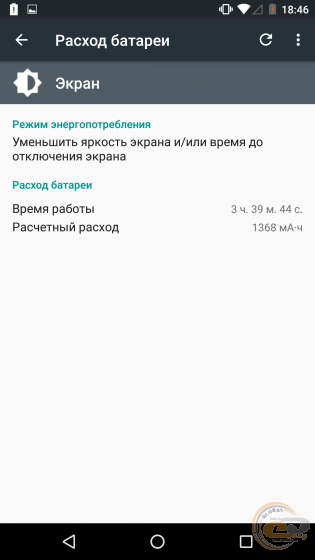
As a result of watching HD video (MPEG-4 / AVC, MKV container, 4 Mbps stream), the device was discharged in 8 hours and 24 minutes. A game simulation using Asphalt 8: Airborne ran out of battery power in 3 hours and 39 minutes.
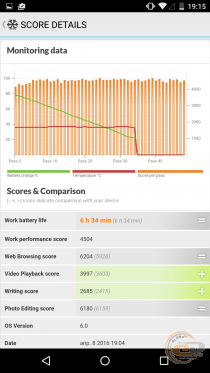
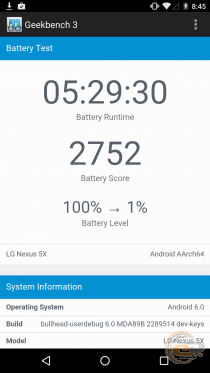
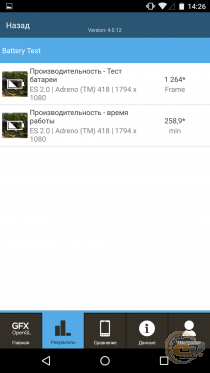
The estimated battery life according to the PCMark benchmark showed 6.5 hours, according to the Geekbench 3 test - about 5.5 hours, while the GFXBench benchmark gave a result of 259 minutes. In all cases (except for the game), the display brightness was 50%, and the Wi-Fi and GPS modules were also activated.
The battery charging time from an incomplete power supply (5 V, 1 A) reaches 3.5 hours.
Results

Undoubtedly, LGNexus 5 X− a very interesting and balanced smartphone. If we compare it with its progenitor, then the novelty is better in everything, except that the design has lost its individuality and recognition. Otherwise, it is a light, nice, albeit plastic, monoblock with a fingerprint scanner, a high-quality screen, an excellent camera, high performance and good autonomy. Perhaps the main advantage of the device can be considered a clean version of Android 6.0 Marshmallow OS and further support from the manufacturer and developers for a few more years.
Now about the sad. As mentioned at the beginning of the article, users fell in love with the Google Nexus line for a good combination of price and features. Despite the recommended cost of $379 (UAH 9,536) for the US, excluding taxes, LG Nexus 5X is asked for around $476 (UAH 11,999) on the domestic market. And this just falls on a par with last year's flagships, and against their background it does not look so interesting. The same one can offer a more interesting design, a better screen and a better audio subsystem, an advanced camera, 3 GB of RAM, support for two SIM cards and a memory card, and a replaceable battery.
In any case, the final choice is always yours. If you are not looking for megapixels or parrots in benchmarks, but want to get a quality smartphone with an unloaded and perfectly optimized OS version and everything you need for work and entertainment, then the LG Nexus 5X is a worthy candidate.
Advantages:
- nice appearance;
- high-quality body assembly;
- the presence of a fingerprint scanner and a symmetrical USB 2.0 Type-C port;
- good IPS display with Full HD resolution and high-quality anti-reflective and oleophobic coatings;
- excellent digital camera modules;
- high performance and good energy efficiency of the hardware platform;
- support for global positioning systems GPS (A-GPS) and GLONASS;
- the presence of NFC, Bluetooth 4.2 and dual-band Wi-Fi with support for the 802.11ac standard;
- USB OTG specification support;
- current version of Android OS.
Disadvantages:
- lack of support for memory cards;
- overpriced in the domestic market.

We express our gratitude to the Ukrainian representative office of the company LG Electronics for the smartphone provided for testing.
